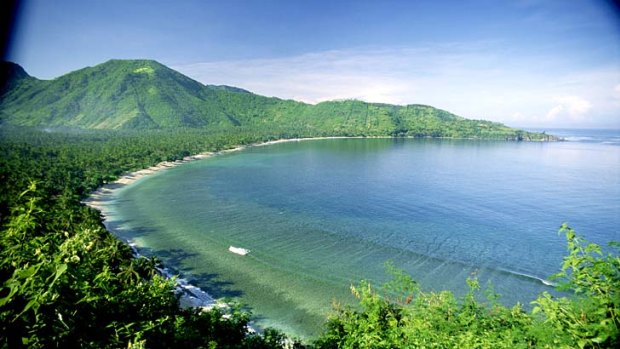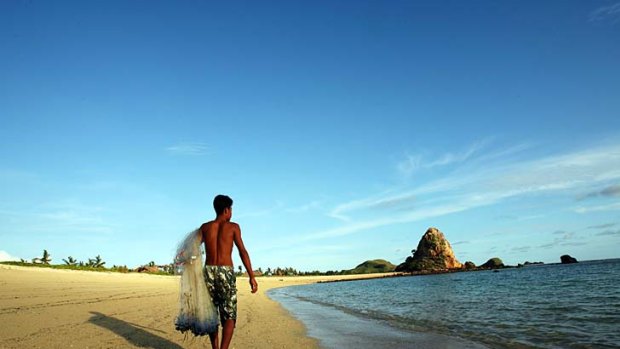
Better than Bali ... Lombok's trump card is its wonderful coastline.Credit: Getty Images
Lombok doesn't have the glamour of Bali, but it does have better beaches and fewer tourists, writes Michelle Jana Chan.
'Crowds came to watch when this airport first opened," a local businessman tells me. "Families brought picnics and spent the day here. Some had not even seen a plane before. They cheered every time one landed."
The people of Lombok will have to get used to the phenomenon of jets touching down. Lombok's new airport, five times larger than the previous one, marks a serious attempt to raise the island's game as a tourist destination. The build-it-and-they-will-come strategy aims to attract visitors who might otherwise have chosen neighbouring Bali or elsewhere in south-east Asia. Garuda and SilkAir, an offshoot of Singapore Airlines, operate international flights to Lombok. Malaysia's low-cost AirAsia says it is also planning to do so. During my stay, the first chartered jet from Moscow landed, delivering a planeload of Russians to the tropical sunshine. There are already plans to extend the runway to accommodate the wider-bodied aircraft that operate on long-haul routes.
For the indigenous Sasaks who live in this area, life has already changed. In the past they made a living from growing rice and weaving textiles. Now a substantial stream of their income is from selling sarongs and other souvenirs. One village, Sukarara, a short drive from the airport, has converted almost all the ground floors of its homes into small souvenir shops, with women demonstrating how to use a loom. "In the past we used to have one or two groups come by," says the village's resident guide, who enterprisingly has called himself Uncle Sam. "Now there are more than 100 tourists a day. Business is great."
Some might be disappointed by how swiftly the village has become so commercial; a stopover is more of a shopping tour than an insight into local culture. The challenge for Lombok is whether it can develop its tourism sector while keeping intact its cultural identity and pristine landscapes.
Lombok's trump card is its wonderful coastline: wild surfing beaches in the south; sweeping bays and calm waters on the west coast and the Gili Islands in the north-west. It is also home to Mount Rinjani, a 3726-metre mountain that is arguably more spectacular and certainly less crowded than Mount Kinabalu, the highest peak in Borneo and one of the most popular draws for trekkers in south-east Asia. For those aiming to reach Rinjani's highest point, campsites are located on the rim of the caldera looking down at a blue-green crater lake fringed with bubbling hot springs.

Eastern promise ... a local fisherman on Lombok's southern shore.Credit: Louie Douvis
Read: Climbing Mount Rinjani
Tanjung Aan, a horseshoe-shaped bay popular with serious surfers, has a few fishing villages, a handful of restaurants and souvenir shops and one lonely hotel, the Novotel Lombok. Not for much longer: when the Indonesian president opened the new airport in October, he also announced plans for a 1250-hectare resort.
On the island's north shore there are hopes of luxurious, less-crowded tourism, pioneered by the likes of the Oberoi Group, which opened a 50-villa resort more than a dozen years ago. West of here, the town of Senggigi is also the site of several stylish new properties, including Qunci Pool Villas, and restaurants such as Square and Asmara. Beaches here are sheltered with a backdrop of mountain peaks and sunset views across to the volcanoes of Bali.
From Senggigi it's a 30-minute boat ride to Lombok's most popular destination, the Gili Islands, which are ringed by fine sand and coral reefs. These three islands were visited mainly by backpackers staying at simple beach accommodation. Now the biggest island, Gili Trawangan, hosts resorts, eco-lodges and spa retreats. Clive Riddington, a property developer originally from Britain, says the market has shifted. "In the old days it was all about smoking spliffs and listening to Bob Marley and parties on the beach," he says. "Now the island is going the way of boutique hotels and villa properties. The cost of land has soared."
Of the other two islands, Gili Meno is the least developed and the more peaceful but its beaches have exposed coral at low tide. The most easterly island, Gili Air, has soft sandy beaches and is popular with families. There is still a bohemian feel across all three islands: instead of cars and motorcycles, transport is by bicycle or horse-drawn carts called cidomos.
Fast boats operate between Bali and the Gili Islands, crossing the Lombok Channel in less than two hours. Millions of people visit Bali seeking a beach paradise, but they might do better looking a little to its east.
FAST FACTS
Getting there
Garuda flies to Denpasar from Sydney and Melbourne (about 6hr) for about $750 low-season return including tax; see garuda-indonesia.com. Merpati flies from Denpasar to Mataram, Lombok's biggest city, but can only be paid for using a credit card issued by an Indonesian bank; see merpati.co.id. There are ferries to Lombok from various locations on Bali, or a bus from Denpasar to Mataram; see lombok-network.com/getting_there.htm. Australians can obtain a 30-day visa on arrival for $US25 ($23).
Trekking there
Many of the young men living near Rinjani earn their living as guides or porters; being able to engage with them over the course of a few days is one of the highlights of a volcano climb. If you prefer to hike independently, camping equipment can be hired in Senaru.
Some trekking companies try to persuade walkers to sign up for a three-night expedition, with the extra night at the lake, but the trip is comfortable in two nights.
Bring thermals for night wear. Carry rubbish out of the park but be warned that not everybody else does; the park is not well maintained and there is rubbish at campsites and along the trails.
The best months to climb Rinjani are June and September when there is less rain and fewer tourists. The high season is July and August.
- The Telegraph, London
Sign up for the Traveller Deals newsletter
Get exclusive travel deals delivered straight to your inbox. Sign up now.